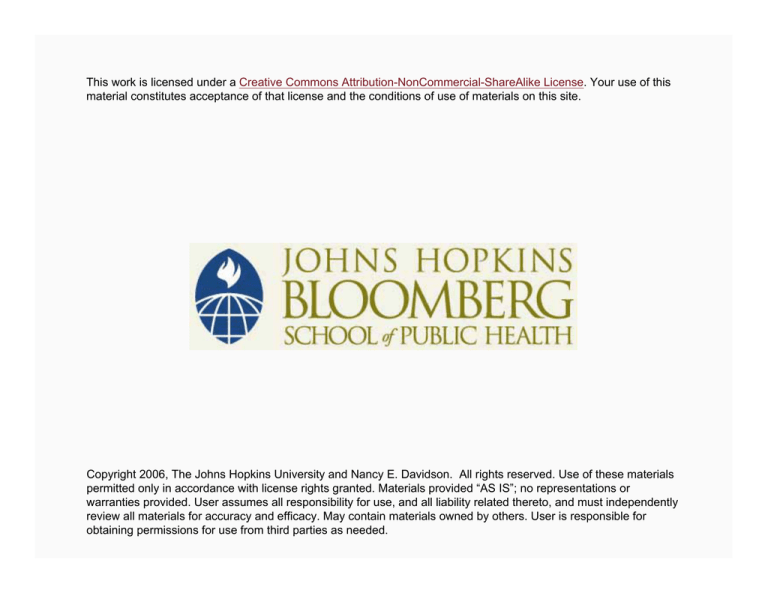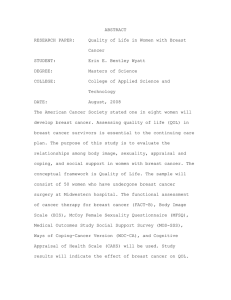
This work is licensed under a Creative Commons Attribution-NonCommercial-ShareAlike License. Your use of this
material constitutes acceptance of that license and the conditions of use of materials on this site.
Copyright 2006, The Johns Hopkins University and Nancy E. Davidson. All rights reserved. Use of these materials
permitted only in accordance with license rights granted. Materials provided “AS IS”; no representations or
warranties provided. User assumes all responsibility for use, and all liability related thereto, and must independently
review all materials for accuracy and efficacy. May contain materials owned by others. User is responsible for
obtaining permissions for use from third parties as needed.
Breast Cancer
Nancy E. Davidson, MD
Johns Hopkins University
Module 5 Introduction, by Dr. Vern Carruthers, PhD
Module 5—breast and prostate cancer
− Most prominent human cancers
− Led by Drs. Nancy Davidson and Terry Brown
3
Breast Cancer: U.S. Statistics 2005
213,000 new cases
40,000 deaths
Lead cancer diagnosis in women
Second leading cause of cancer death in women
4
Potential Applications for Breast Cancer: Biology
Predict risk of cancer development
Estimate prognosis for established cancer
Predict response to therapy
Identify therapeutic targets
5
Section A
Risk of Cancer
Breast Cancer Risk Factors: Demographics
Gender
− Male: female
X 1:100
Age
− 1 in 50 by age 50
− 1 in 8 over lifetime
7
Breast Cancer Risk Factors: Reproductive
Early menarche
Late menopause
Nulliparity or late first pregnancy
? Lactation
8
Breast Cancer Risk Factors: Environmental
Radiation—yes
Pesticides—no
Electromagnetic fields—no
9
Breast Cancer Risk Factors: Lifestyle
Diet
Alcohol
Physical activity
Tobacco
10
Breast Cancer Risk Factors: Endogenous Hormones
? High hormone levels
Post menopausal obesity
Increased bone density
11
Breast Cancer Risk Factors: Exogenous Hormones
Hormone replacement therapy—yes
Estrogen replacement therapy—no?
Oral contraceptives—no
12
Breast Cancer Risk Factors: Pathology
Atypical ductal or lobular hyperplasia
Lobular carcinoma in situ
13
Breast Cancer Risk Factors: Inherited Susceptibility
Family history
Major inherited susceptibility
DNA repair defects
14
How Much Breast and Ovarian Cancer Is Hereditary?
15
Causes of Hereditary Susceptibility to Breast Cancer
Gene
BRCA1
BRCA2
TP53
PTEN
Undiscovered genes
T Notes Available
Contribution to Hereditary
Breast Cancer
20–40%
10–30%
<1%
<1%
30–70%
16
BRCA1
Tumor suppressor gene on chromosome 17
Autosomal dominant transmission
Protein has role in genomic stability
~500 different mutations reported
17
Increased Likelihood of BRCA Mutations
Features that indicate increased likelihood of having
BRCA mutations
− Multiple cases of early onset breast cancer
− Ovarian cancer (with family history of breast or
ovarian cancer)
− Breast and ovarian cancer in the same woman
− Bilateral breast cancer
− Ashkenazi Jewish heritage
− Male breast cancer
18
BRCA1-Associated Cancers: Lifetime Risk
Possible increased risk of other cancers (e.g.,
prostate, colon)
19
BRCA2-Associated Cancers: Lifetime Risk
Increased risk of prostate, laryngeal, and pancreatic
cancers (magnitude unknown)
20
BRCA2-Linked Hereditary Breast Cancer
21
Breast Cancer Risk Estimates in BRCA Mutation Carriers
Adapted by CTLT from: Source: Adapted by Easton, D.F., Ford, D., Bishop, D.T. (1995). Breast and ovarian
cancer incidence in BRCA1-mutation carriers. Breast Cancer Linkage Consortium. Am J Hum Genet; 56:265–71.
Struewing, J.P., Hartge, P., Wacholder, S. (1997), et al. The risk of cancer associated with specific mutations of
BRCA1 and BRCA2 among Ashkenazi Jews. N Engl J Med; 336:1401–8.
22
ASCO.org. See ASCO Curriculum
Options for Carriers of BRCA-1 or BRCA-2 Mutations
Surveillance
Chemoprevention
Prophylactic surgery
23
Section B
Prognosis for Established Cancer
and Response to Therapy
Prognostic Markers for Breast Cancer
Established at the NIH Consensus Conference 2003
− Axillary lymph nodes
− Tumor size
− Histological grade
− Histological tumor type
− Steroid receptor states
− Age
T Notes Available
Continued
25
Prognostic Markers for Breast Cancer
Established at the NIH Consensus Conference 2003
− Axillary lymph nodes
− Tumor size
− Histological grade
− Histological tumor type
− Steroid receptor states
− Age
T Notes Available
26
Potential Applications for Breast Cancer Biology
Predict risk of cancer development
Estimate prognosis for established cancer
Predict response to therapy
Identify therapeutic targets
27
The Estrogen Receptors
Source: Adapted by Osborne, C.K., Zhao, H., Fuqua, S.A. (2000).
Selective estrogen receptor modulators: structure, function, and clinical use. J Clin Oncol; 18:3172–86.
28
Steroid Receptors in Breast Cancer
Steroid Receptors in Breast Cancer
Tumor phenotype
Phenotype frequency
Response to hormonal
therapy
ER+/PR+
41%
75–80%
ER+/PR-
30%
20–30%
ER-/PR+
2%
40–45%
ER-/PR-
27%
<10%
McGuire 1978
Source: McGuire (1978)
29
Endocrine Therapy for Breast Cancer
Ovarian ablation—surgery, radiation, LHRH agonists
SERMs—tamoxifen, toremifene, fulvestrant
Aromatase inhibitors—anastrozole, letrozole,
exemestane
Additive—progestins, estrogens, androgens
30
Some Possible Mechanisms of Hormone Resistance
Loss of ER expression
− Mutation or deletion
− Promoter methylation
− Altered transcriptional factors
Altered coactivators or corepressors
Alternative growth factor pathways
Drug delivery
31
The EGFR (ErbB) Family and Ligands
32
HER 2 As a Predictive Marker for Trastuzumab
HER 2 as a Predictive Marker for Trastuzumab
HER 2 Status
Response Rate
IHC 3+
35%
IHC 2+
0
FISH positive
34%
FISH negative
7%
Vogel JCO 2002
Source: Vogel (2002), JCO
33
HER 2 as a Predictive Marker
? Resistance to tamoxifen
? Response to anthracycline
34
Section C
New Therapeutic Targets for Breast Cancer
The EGFR (ErbB) Family and Ligands
36
EGFR Signal Transduction in Tumor Cells
37
Available Forms of Anti-EGFR Therapy
Antibody-based
− Cetuximab
Small molecule TKI
− Gefitinib
− OSI774
38
Therapy Against Other Targets
Anti-angiogenic
− anti–VEGF
X bevacizumab
Matrix metalloproteinase inhibitors
Bisphosphonates
39
Bevacizumab for Breast Cancer
Twenty percent clinical benefit in advanced
breast cancer
Paclitaxel
Advanced
breast cancer
Paclitaxel
Bevacizumab
40
Matrix Metalloproteinase Inhibitors for Breast
Cancer
No effect on time to progression
Marimastat
CR, PR, or SD
after chemo
Placebo
T Notes Available
41
Application of Arrays
Different profile of sporadic versus hereditary breast
cancer
− Heldenfalk et al. (2001), NEJM
Identify subset of young women with poor prognosis
early breast cancer
− van’t Veer et al. (2002), Nature
Lack of profile for response to doxorubicin
− Perou et al. (2000), Nature
42
Oncotype DX Breast Cancer Assay
Now available—$3400
Should we use it?
For whom?
How?
43
Candidate Gene Selection
Candidate gene selection from ~40,000 genes
M
y
rra
oa
icr a*
t
Da
er re
n c at u
Ca iter
L
Ge
Da nom
ta
ba ic
se
s
ar
l
u
ec y
l
o
M olog
Bi
250
cancer-related
candidate genes
Example Papers: Van 't Veer et al. (2002). Nature; 415:530;
Sorlie, et al. (2001). Proc. Natl. Acad. Sci. U.S.A.; 98:10869;
Ramaswamy, et al. (2003). Nature Genetics;Paik
33:4;et al, SABCS 2003
Gruvberger et al. (2001). Cancer Res; 61:5979
44
Three Breast Cancer Studies Used to Select
Source: Adapted by CTLT from Paik et al. (Dec. 30, 2004) N Engl J Med.
45
Three Studies Develop Recurrence Score (RS) Algorithm
Three Breast Cancer Studies Used to Develop
Recurrence Score (RS) Algorithm
RS = +0.47 x HER2 Group Score
-0.34 x ER Group Score
+1.04 x Proliferation Group Score
+0.10 x Invasion Group Score
+0.05 x CD68
-0.08 x GSTM1
-0.07 x BAG1
Continued
46
Three Studies Develop Recurrence Score (RS) Algorithm
Recurrence Category
RS (0–100)
Low risk
<18
Intermediate risk
18–30
High risk
• 31
47
Genomic Health-NSABP B-14
Prospective Clinical Validation Study
Objective
− Validate Recurrence Score as predictor of distant
recurrence in N-, ER+, tamoxifen-treated patients
Design
Placebo—Not Eligible
Randomized
Tamoxifen—Eligible
B-14
−
−
Registered
Tamoxifen—Eligible
Pre-specified 21 gene assay, algorithm, endpoints,
analysis plan
Blinded laboratory analysis of three 10 µ sections
Paik et al, SABCS 2003
48
B14 Clinical Results
DRFS—All 668 Patients
Source: Adapted by CTLT from Paik et al. (Dec. 30, 2004), N Engl J Med.
49
Study Design
B-14 Results
− First Primary Objective
X Validate that 10 year DRFS in the low-risk
group (RS < 18) is significantly higher than 10
year DRFS in the high risk group (RS ≥ 31)
X Assuming: binomial test for differences in
proportions = 0; α = 0.05; 600 evaluable
patients—240 low-risk patients with DRFS 0.90
and 150 high-risk patients with DRFS 0.70;
then power >95%
Paik et al, SABCS 2003
Source: Adapted by CTLT from Paik et al. (Dec. 30, 2004), N Engl J Med.
50
B-14 Results
DRFS—Low-, Intermediate-, and High-RS Groups
Percentage of
Patients
10-year Rate
Recurrence
95% CI
Low (RS < 18)
51%
6.8%
4.0%, 9.6%
Intermediate
(RS 18–30)
22%
14.3%
8.3%, 20.3%
30.5%
23.6%,
37.4%
Risk Group
High (RS • 31)
27%
Test for the 10-year DRFS comparison between the low- and high-risk groups: p<0.0001
Source: Adapted by CTLT from Paik et al. (Dec. 30, 2004), N Engl J Med.
Continued
51
B14-Results
DRFS—Low-, Intermediate-, High-RS Groups
Source: Adapted by CTLT from Paik et al. (Dec. 30, 2004), N Engl J Med.
52
Recurrence Score As a Continuous Predictor
Source: Adapted by CTLT from Paik et al. (Dec. 30, 2004), N Engl J Med.
53
Potential Applications for Breast Cancer Biology
Predict risk of cancer development
Estimate prognosis for established cancer
Predict response to therapy
Identify therapeutic targets
54








